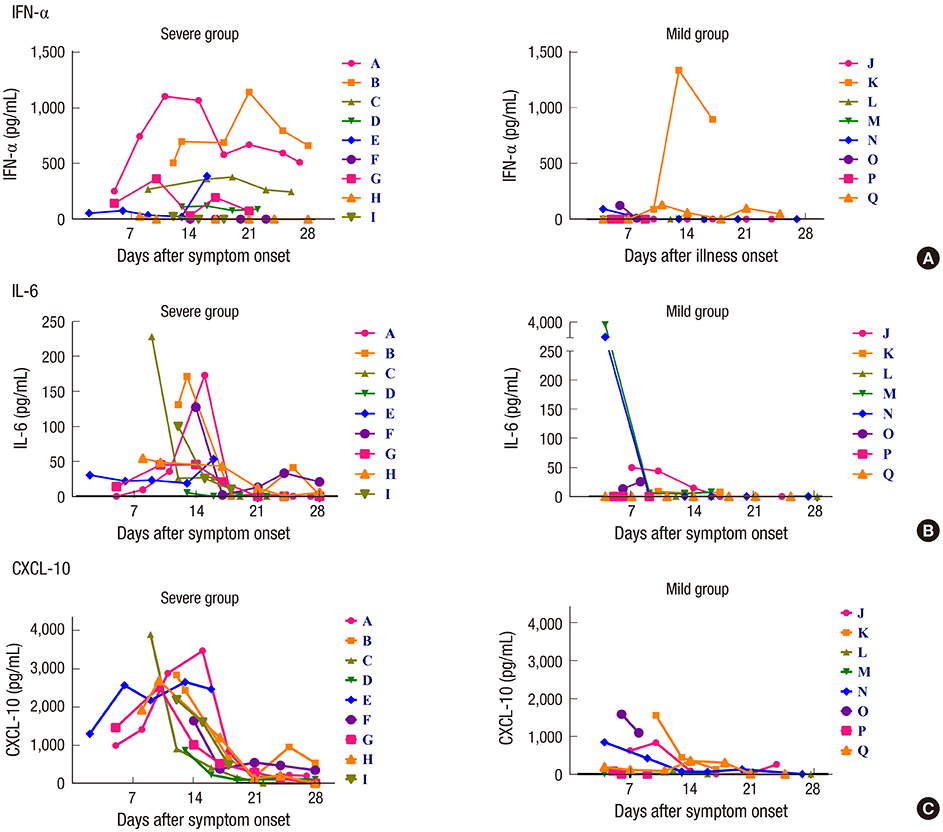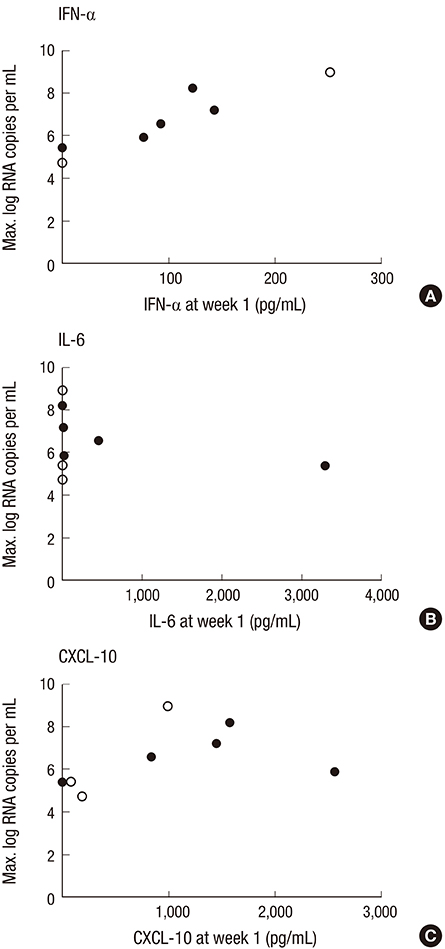J Korean Med Sci.
2016 Nov;31(11):1717-1725. 10.3346/jkms.2016.31.11.1717.
Clinical Progression and Cytokine Profiles of Middle East Respiratory Syndrome Coronavirus Infection
- Affiliations
-
- 1Department of Internal Medicine, Seoul National University College of Medicine, Seoul, Korea. mdohmd@snu.ac.kr
- KMID: 2470266
- DOI: http://doi.org/10.3346/jkms.2016.31.11.1717
Abstract
- Clinical progression over time and cytokine profiles have not been well defined in patients with Middle East respiratory syndrome coronavirus (MERS-CoV) infection. We included 17 patients with laboratory-confirmed MERS-CoV during the 2015 outbreak in Korea. Clinical and laboratory parameters were collected prospectively. Serum cytokine and chemokine levels in serial serum samples were measured using enzyme-linked immunosorbent assay. All patients presented with fever. The median time to defervescence was 18 days. Nine patients required oxygen supplementation and classified into severe group. In the severe group, chest infiltrates suddenly began to worsen around day 7 of illness, and dyspnea developed at the end of the first week and became apparent in the second week. Median time from symptom onset to oxygen supplementation was 8 days. The severe group had higher neutrophil counts during week 1 than the mild group (4,500 vs. 2,200/µL, P = 0.026). In the second week of illness, the severe group had higher serum levels of IL-6 (54 vs. 4 pg/mL, P = 0.006) and CXCL-10 (2,642 vs. 382 pg/mL, P < 0.001). IFN-α response was not observed in mild cases. Our data shows that clinical condition may suddenly deteriorate around 7 days of illness and the serum levels of IL-6 and CXCL-10 was significantly elevated in MERS-CoV patients who developed severe diseases.
Keyword
MeSH Terms
-
Adult
Aged
Body Temperature
Chemokine CXCL10/blood
Chemokines/blood
Coronavirus Infections/blood/complications/*pathology
Creatinine/blood
Cytokines/*blood
Disease Progression
Dyspnea/etiology
Enzyme-Linked Immunosorbent Assay
Female
Humans
Hyperbaric Oxygenation
Interferon-gamma/blood
Interleukin-6/blood
Leukocyte Count
Male
Middle Aged
Neutrophils/cytology
Prothrombin Time
Severity of Illness Index
Chemokine CXCL10
Chemokines
Cytokines
Interleukin-6
Interferon-gamma
Creatinine
Figure
Cited by 2 articles
-
An Atypical Case of Middle East Respiratory Syndrome in a Returning Traveler to Korea from Kuwait, 2018
Song Lee Bak, Kang Il Jun, Jongtak Jung, Jeong-Han Kim, Chang Kyung Kang, Wan Beom Park, Nam-Joong Kim, Myoung-don Oh
J Korean Med Sci. 2018;33(53):. doi: 10.3346/jkms.2018.33.e348.The First Case of 2019 Novel Coronavirus Pneumonia Imported into Korea from Wuhan, China: Implication for Infection Prevention and Control Measures
Jin Yong Kim, Pyoeng Gyun Choe, Yoonju Oh, Kyung Joong Oh, Jinsil Kim, So Jeong Park, Ji Hye Park, Hye Kyoung Na, Myoung-don Oh
J Korean Med Sci. 2020;35(5):. doi: 10.3346/jkms.2020.35.e61.
Reference
-
1. Zaki AM, van Boheemen S, Bestebroer TM, Osterhaus AD, Fouchier RA. Isolation of a novel coronavirus from a man with pneumonia in Saudi Arabia. N Engl J Med. 2012; 367:1814–1820.2. World Health Organization. Middle East respiratory syndrome coronavirus (MERS-CoV) - Saudi Arabia: disease outbreak news, 14 April 2016 [Internet]. updated on 14 April 2016. accessed on 20 April 2016. Available at http://www.who.int/csr/don/14-april-2016-mers-saudi-arabia/en/.3. Lee J. Better understanding on MERS corona virus outbreak in Korea. J Korean Med Sci. 2015; 30:835–836.4. Korea Centers for Disease Control and Prevention. Middle East respiratory syndrome coronavirus outbreak in the Republic of Korea, 2015. Osong Public Health Res Perspect. 2015; 6:269–278.5. Oh MD, Choe PG, Oh HS, Park WB, Lee SM, Park J, Lee SK, Song JS, Kim NJ. Middle East respiratory syndrome coronavirus superspreading event involving 81 persons, Korea 2015. J Korean Med Sci. 2015; 30:1701–1705.6. World Health Organization. Summary and risk assessment of current situation in Republic of Korea and China: MERS-CoV risk assessment, 19 June 2015 [Internet]. updated on 19 June 2015. accessed on 17 September 2015. Available at http://who.int/csr/disease/coronavirus_infections/risk-assessment-19june2015/en/.7. de Jong MD, Simmons CP, Thanh TT, Hien VM, Smith GJ, Chau TN, Hoang DM, Chau NV, Khanh TH, Dong VC, et al. Fatal outcome of human influenza A (H5N1) is associated with high viral load and hypercytokinemia. Nat Med. 2006; 12:1203–1207.8. Wang Z, Zhang A, Wan Y, Liu X, Qiu C, Xi X, Ren Y, Wang J, Dong Y, Bao M, et al. Early hypercytokinemia is associated with interferon-induced transmembrane protein-3 dysfunction and predictive of fatal H7N9 infection. Proc Natl Acad Sci USA. 2014; 111:769–774.9. Wong CK, Lam CW, Wu AK, Ip WK, Lee NL, Chan IH, Lit LC, Hui DS, Chan MH, Chung SS, et al. Plasma inflammatory cytokines and chemokines in severe acute respiratory syndrome. Clin Exp Immunol. 2004; 136:95–103.10. Oh MD, Park WB, Choe PG, Choi SJ, Kim JI, Chae J, Park SS, Kim EC, Oh HS, Kim EJ, et al. Viral load kinetics of MERS coronavirus infection. N Engl J Med. 2016; Forthcoming.11. Park WB, Perera RA, Choe PG, Lau EH, Choi SJ, Chun JY, Oh HS, Song KH, Bang JH, Kim ES, et al. Kinetics of serologic responses to MERS coronavirus infection in humans, South Korea. Emerg Infect Dis. 2015; 21:2186–2189.12. World Health Organization. Laboratory testing for Middle East respiratory syndrome coronavirus: interim guidance [Internet]. updated on June 2015. accessed on17 September 2015. Available at http://www.who.int/csr/disease/coronavirus_infections/mers-laboratory-testing/en/.13. Wang WK, Chen SY, Liu IJ, Kao CL, Chen HL, Chiang BL, Wang JT, Sheng WH, Hsueh PR, Yang CF, et al. Temporal relationship of viral load, ribavirin, interleukin (IL)-6, IL-8, and clinical progression in patients with severe acute respiratory syndrome. Clin Infect Dis. 2004; 39:1071–1075.14. Assiri A, Al-Tawfiq JA, Al-Rabeeah AA, Al-Rabiah FA, Al-Hajjar S, Al-Barrak A, Flemban H, Al-Nassir WN, Balkhy HH, Al-Hakeem RF, et al. Epidemiological, demographic, and clinical characteristics of 47 cases of Middle East respiratory syndrome coronavirus disease from Saudi Arabia: a descriptive study. Lancet Infect Dis. 2013; 13:752–761.15. Assiri A, McGeer A, Perl TM, Price CS, Al Rabeeah AA, Cummings DA, Alabdullatif ZN, Assad M, Almulhim A, Makhdoom H, et al. Hospital outbreak of Middle East respiratory syndrome coronavirus. N Engl J Med. 2013; 369:407–416.16. Peiris JS, Chu CM, Cheng VC, Chan KS, Hung IF, Poon LL, Law KI, Tang BS, Hon TY, Chan CS, et al. Clinical progression and viral load in a community outbreak of coronavirus-associated SARS pneumonia: a prospective study. Lancet. 2003; 361:1767–1772.17. Saad M, Omrani AS, Baig K, Bahloul A, Elzein F, Matin MA, Selim MA, Al Mutairi M, Al Nakhli D, Al Aidaroos AY, et al. Clinical aspects and outcomes of 70 patients with Middle East respiratory syndrome coronavirus infection: a single-center experience in Saudi Arabia. Int J Infect Dis. 2014; 29:301–306.18. Al-Tawfiq JA, Hinedi K, Ghandour J, Khairalla H, Musleh S, Ujayli A, Memish ZA. Middle East respiratory syndrome coronavirus: a case-control study of hospitalized patients. Clin Infect Dis. 2014; 59:160–165.19. Arabi YM, Arifi AA, Balkhy HH, Najm H, Aldawood AS, Ghabashi A, Hawa H, Alothman A, Khaldi A, Al Raiy B. Clinical course and outcomes of critically ill patients with Middle East respiratory syndrome coronavirus infection. Ann Intern Med. 2014; 160:389–397.20. Menachery VD, Eisfeld AJ, Schäfer A, Josset L, Sims AC, Proll S, Fan S, Li C, Neumann G, Tilton SC, et al. Pathogenic influenza viruses and coronaviruses utilize similar and contrasting approaches to control interferon-stimulated gene responses. MBio. 2014; 5:e01174–14.21. Faure E, Poissy J, Goffard A, Fournier C, Kipnis E, Titecat M, Bortolotti P, Martinez L, Dubucquoi S, Dessein R, et al. Distinct immune response in two MERS-CoV-infected patients: can we go from bench to bedside? PLoS One. 2014; 9:e88716.22. Lee N, Wong CK, Chan PK, Lun SW, Lui G, Wong B, Hui DS, Lam CW, Cockram CS, Choi KW, et al. Hypercytokinemia and hyperactivation of phospho-p38 mitogen-activated protein kinase in severe human influenza A virus infection. Clin Infect Dis. 2007; 45:723–731.23. Lee N, Wong CK, Chan PK, Chan MC, Wong RY, Lun SW, Ngai KL, Lui GC, Wong BC, Lee SK, et al. Cytokine response patterns in severe pandemic 2009 H1N1 and seasonal influenza among hospitalized adults. PLoS One. 2011; 6:e26050.24. Chi Y, Zhu Y, Wen T, Cui L, Ge Y, Jiao Y, Wu T, Ge A, Ji H, Xu K, et al. Cytokine and chemokine levels in patients infected with the novel avian influenza A (H7N9) virus in China. J Infect Dis. 2013; 208:1962–1967.25. Zhou J, Chu H, Li C, Wong BH, Cheng ZS, Poon VK, Sun T, Lau CC, Wong KK, Chan JY, et al. Active replication of Middle East respiratory syndrome coronavirus and aberrant induction of inflammatory cytokines and chemokines in human macrophages: implications for pathogenesis. J Infect Dis. 2014; 209:1331–1342.26. de Wit E, Rasmussen AL, Falzarano D, Bushmaker T, Feldmann F, Brining DL, Fischer ER, Martellaro C, Okumura A, Chang J, et al. Middle East respiratory syndrome coronavirus (MERS-CoV) causes transient lower respiratory tract infection in rhesus macaques. Proc Natl Acad Sci USA. 2013; 110:16598–16603.
- Full Text Links
- Actions
-
Cited
- CITED
-
- Close
- Share
- Similar articles
-
- An Unexpected Outbreak of Middle East Respiratory Syndrome Coronavirus Infection in the Republic of Korea, 2015
- The Korean Middle East Respiratory Syndrome Coronavirus Outbreak and Our Responsibility to the Global Scientific Community
- The Same Middle East Respiratory Syndrome-Coronavirus (MERS-CoV) yet Different Outbreak Patterns and Public Health Impacts on the Far East Expert Opinion from the Rapid Response Team of the Republic of Korea
- Middle East Respiratory Syndrome Coronavirus Infection in Children
- A Fatal Case of Middle East Respiratory Syndrome Corona Virus Infection in South Korea: Chest Radiography and CT Findings




